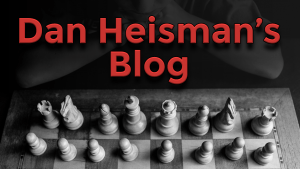Q&A with Coach Heisman Jan 4, 2013
At the beginning of this week's show almost every question involved openings. Don't get me wrong; I think openings are important - it's the only part of the game which you are guaranteed to reach each time you play. But this obsession with openings - especially the less important aspect of openings when your rating is low, such as how much difference it will make in your development if you pick opening X vs opening Y (it could be large, but usually much smaller than other factors), is unfortunate, if hardly baffling.
In their book Chess Rules of Thumb, GM Alburt and Lawrence quoted me (#283) "Any opening you know well is good no matter its reputation." so I guess by its inclusion they were asserting their agreement.
Let's do a little thought experiment. Let's assume that, aside from getting the opponent to fall into a losing trap, that the player who does his opening homework (picks the proper opening and follows the suggested lines better than the opponent) can be guaranteed a small advantage, say 0.3 on a computer scale or +/= in human evaluation terms at the end of the opening. (By the way, except for the Open Sicilian and the King's Indian Defense, where most computers tend to like White, an opening advantage in most popular lines is usually about half that, 0.1-0.2). With that 0.3 advantage, how would this affect your betting on the outcome of the game (i.e., what odds you would give in a bet on the player with the advantage out of the opening) if:
- Both players were rated 700,
- Both players were rated 1200,
- Both players were rated 1700,
- Both players were rated 2200, or
- Both players were rated 2700?
My guess is that a 0.3 advantage for a 700 is worth about zero betting advantage. His chances are 50-50. Whoever makes the big tactical mistakes will lose. Normally for GMs the player with the advantage is the only one who will get the tactics ("Tactics flow from superior positions"), but this is hardly true at the lower levels, where the player with the advantage is just as likely to make a basic tactic error as his opponent. Pretty much the same argument would apply to the 1200's. Only at 1700, well about tournament average, would we think a player with a 0.3 advantage out of the opening would have a meaningful betting advantage, but it would not be much. If you take the player with the advantage and offer me 2-1 odds, I could retire easily with enough of those bets. Even at 2200 (near my level), 0.3 is no guarantee that things will be going your way throughout the opening and middlegame. According to the engines, I lose that kind of advantage in one slightly inaccurate move all the time! At 2700 however, 0.3 is a real pull. It could be tough sledding for the underdog. But even so I would take the 2700 player at the disadvantage if given 2-1 overall (draws included, not just wins) odds.
But this thought experiment means that all that study to get a normal opening advantage, which did a world of good for the 2700's, did not mean nearly as much for us mortals. I noted that about 99% of the games I have reviewed between two players rated 1500 or below featured an easy "Bain-level" (the author of Chess Tactics for Students) tactic where one side or the other could have won material or checkmated. Given that statistic, spending much of your time learning how to get a 0.3 advantage instead of effort that would avoid being on the bad side of the tactic (such as repetitious study of easy tactics) seems a poor use of your development time.
When you work on openings, it would at least help if that would include follow good basic principles when you get out of your "book" such as Move every piece once before you move every piece twice, unless there is a tactic. This is a principle that players under 1500 rarely follow, instead choosing to often play the opening as if it were the middlegame.
Yet when I tell the viewers that working on their analysis skills, especially their basic tactics, time management, and thought process skills, are far more likely to provide meaningful benefits than picking out the Caro-Kann over the Two Knights Defense, it often comes across as a revelation. And a revelation that does not stick very well because next show we are back to the same old "I am 1300 and thinking of taking up the Pirc - what do you think?" questions.
In a similar vein are the open-ended questions. One I received tonight was "What do you think about correspondence chess and 960 chess?" On the surface this is a very reasonable question and my opinions on these types of chess might be of interest. But what the questioner is usually interested in is not just my general opinion, but how these activities will help their goals. There is only one problem: their goals are implied but not stated. If your goal is to be an over-the-board expert or above ("titled player"), then putting these activities in that context (how they help achieve that goal) is quite different than answering whether I think those chess activities are fun - for me, or for some player considering taking up the challenge. Similarly, playing computers is wonderful if your goal is to beat computers; not nearly so helpful if your goal is to beat humans, who play quite differently - not only in the kind of errors they make, but in their time management (since most computers programmed to play weak/competitively can do so immediately).
One of the things I emphsized at the end of the show was that learning another opening line would certainly be far less effective than learning how to recognize if a move is safe, and doing it consistently. In my experience teaching about 1,000 players privately, most every player rated under 1700 does not consistently check if their candidate moves are safe, which requires a two-step process:
1. Ask yourself if your candidate move is safe. This may seem obvious, but this step is skipped by most (I ought to know - I test students for this!); they might ask if the piece they are moving is adequately guarded on its destination square, but that is a far cry from asking "Can I meet every dangerous check, capture, or threat which my opponent could play after I make this move? Just because the moved piece is safe does not mean your entire position is so - there are 63 other squares on the board where you might be losing something!
2. Determine the answer. This is primarily accomplished by one of two methods:
a. Knowledge = pattern recognition. For example, in the following position
...most players 1200 or above correctly answer "No" but, if I had not asked the question (forced the first step upon them!), the average rating needed to avoid the capture would rise. In this case the extremely common pattern after 1...Qxb5?? 2.Qh6 threatening the unstoppable 3.Qg7# usually causes the danger to be noticed. Note that because 2.Qh6 is an unstoppable threat, waiting until after White makes the move to determine what to do ("Hope Chess") will consistently result in the opponent making threats you cannot meet. I played this way in my first three USCF tournaments and did not win more than one game in any of the swiss events! No matter how smart or how long you take on your move, you won't find an answer to those unstoppable threats so taking the time to avoid trouble is much more effective than taking time to get out of it.
b. Analysis = skill in calculating the safety in positions that can't be fully addressed just by pattern recognition. Of course, if you ask "Is my intended move safe?" and don't spot a pattern, that doesn't mean that there isn't one! So it is very helpful, but hardly sufficient, to recognize many tactical patterns for your opponent so you can avoid them. In some positions you just have to roll up your sleeves and carefully figure it out. The more you do that, the better you will get at it. But playing 15 minute chess will rarely provide the opportunity to do that consistently. If the average game is 40 moves and there are 15x60 = 900 seconds on your clock, that is only 22.5 seconds per move. That's hardly enough to follow the #1 principle in chess When you see a good move, don't make it; look for a better one, much less our two steps presented here to determine if each candidate move you consider is safe.
Finally, one question was the common but still interesting "Who do you think is the best player of all time?" Like in other sports, this "best" definition involves the question of peak rating versus longevity: would you rather have Sandy Koufax or Greg Maddux in baseball or Bill Walton vs Patrick Ewing in basketball? I think the peak ratings (adjusted for inflation) of Garry Kasparov and Bobby Fischer were equivalent, but Kasparov wins any longevity tiebreak, hands-down. And the recent rating record breaker, Magnus Carlsen, has to start entering the discussion. Let's hope that FIDE changes the rules in such a way that Magnus will play for the title next time. The gap between Carlsen and WC Anand (89 points as of this writing) is now, I believe, bigger than the previous "WC deficit" record of Spassky's 2690 to Fischer's 2760 (don't forget the inflation!) before the 1972 match.






